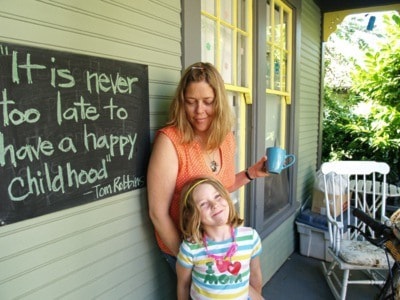One student balances studies with single parenthood
K.C. Logan, mother to an energetic six-year-old girl, hits the ground running in the mornings.
Most days begin with the typical chaos of parenthood: preparing breakfast, packing a lunchbox, picking up the tornado-like mess that small children create and hurtling out the door. Once she has dropped her daughter at school, Logan rushes to Camosun College to attend her own classes.
Logan, 43, returned to school two years ago to become a child psychologist. It entailed a commitment of at least five years before she would be able to start practising and she plans to complete a doctorate after that.
As a mature student, Logan does not feel unusual sitting in the classroom. In 2010, 38 per cent of Camosun students were over 30, a trend reflected in colleges and universities across the country. While students of all ages face similar concerns, including financial struggles and heavy academic workloads, older students also often juggle families, mortgages and other responsibilities.
Before enrolling at Camosun, Logan tended bar for many years, with stints in retail and waitressing. Going through a divorce shook up her and her daughter's lives and inspired her to choose a new career path.
“I watched my child struggle with the changing family structure and there was no professional support available for children under the age of six. There is a real need for that here. I plan to work with kids between two and five with upheaval in their family lives.”
As a single parent, scheduling classes and study time can be challenging for Logan. She needs to fit her classes into her daughter's school hours and often must find babysitters when she sits for exams. “I have to plan my time much more carefully than I did in my younger university days. I can't stay up all night working on an assignment. Finding enough time to study for exams is sometimes just not possible.”
David Sovka, Camosun College student marketing and recruitment associate director, says the needs of the increasing number of adult students are guiding change in post-secondary institutions.
“Courses used to be Monday to Friday, nine to five. Now we offer courses at other times of the day to accommodate students who are working and going to school,” he says. “We are also expanding the locations where we offer key courses. For example, starting in September, we will be offering six courses on the West Shore, so people who live in that area can avoid the traffic and travel time of coming to our Lansdowne campus.”
Camosun and the University of Victoria offer on-campus child care, which is always in high demand. Royal Roads, catering to a student population with an average age of 42, offers blended programs combining online coursework with short-term residencies, allowing students to continue working and study at home around their schedules.
Sovka says enrolment of students already in the workforce can be linked to economic cycles.
“When the economy tanks, we see increased mature student numbers in most sectors. Whether they are returning to school to pursue their dreams, or aiming to reposition themselves to make more money, when the economy slows down, it often makes sense to go back to school.”
An exception to this trend is the trades sector. Trades programs require apprenticeships, which depend on a healthy economy for positions to be available.
Michael Atkinson has been working as an uncertified carpenter for 22 years. After the economic downturn, wages in his industry dropped substantially, prompting him to pursue certification to increase his employability.
Having the work experience under his belt, he didn't need to complete an apprenticeship and completed his school terms back-to-back, finishing last September. Although he was in a much better position than students just entering the trades – they need four years to complete their programs – Atkinson found it very difficult financially.
“I have a wife and a young child and the cost of living in Victoria just doesn't match the wages," he says. "Without my paycheques coming in, it was tough to pay the bills.”
Now certified, Atkinson plans to pay off his debts by heading to Saskatchewan to work in the potash industry.
While going to school presents a massive financial commitment for anyone, adult students may have a different approach when it comes to taking on a massive debt burden.
Logan, currently receiving student loans, says she takes the debt more seriously then she did when she was younger.
“At that time I was at university because it was what was expected, not out of a sense of deep commitment. And to me, the loans were a bit of a joke.”
Now she sees it as a necessary step in the accomplishment of her goals. She intends to be able to pay off the debt with a well-paying practice.
“It's important to really know what you want to do with your education, because you can end up owing a huge amount of money. You need a goal to motivate you and a plan to get yourself out of debt once you finish your schooling.”
That is one piece of advice many of us who went to school in our younger days may wish we had taken to heart.
